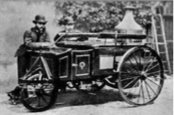The American Dream is an idea that most Americans are familiar with: the idea that almost anyone can make it and make something of themselves no matter what their background is. This idea of coming from nothing to doing whatever you want is what led to and encouraged many to immigrate to the United States in the late 19th and early 20th century. In my family, my great-great grandfather Charles George came from nothing to become an engineer in the automobile industry in Detroit in the 1900s.
It all started when Charles George’s father William Henry George came to the United States from England in 1866. Like most immigrants to the United States, William Henry George was very poor and worked as a miner in the Detroit area of Michigan for most of his life. In 1872, just 6 years after arriving in the United States, William Henry George and his wife had Charles George, who was the fifth born of six children. Even though Charles was born into a very large, poor family, he didn’t let that stop him. In 1900, when he  was only 28 years old, he became a stationary engineer (now commonly called a power engineer), as shown in the Census Report on the left. Power engineers normally work with heavy machinery that provides heat or some type of power. Seeing more job opportunities in the automobile industry, Charles changed his career path to work in the ever-growing industry of Detroit. In 1920, Charles became a Steam Engineer for a car company (as shown in the Census Report to the right). At this company he was most likely designing and building cars that were powered by steam, which at the time was a huge
was only 28 years old, he became a stationary engineer (now commonly called a power engineer), as shown in the Census Report on the left. Power engineers normally work with heavy machinery that provides heat or some type of power. Seeing more job opportunities in the automobile industry, Charles changed his career path to work in the ever-growing industry of Detroit. In 1920, Charles became a Steam Engineer for a car company (as shown in the Census Report to the right). At this company he was most likely designing and building cars that were powered by steam, which at the time was a huge advancement in the auto industry. The Stanley Motor Carriage Company had just broken the land speed record with their Stanley Steamer steam car going 127 MPH. This record, combined with the fact that steam engines had become safer and cheaper, made the auto industry really look into making steam cars, like the one to the left, for consumers. The steam car seemed like a possibility until the late 1920s, when internal combustion engine cars
advancement in the auto industry. The Stanley Motor Carriage Company had just broken the land speed record with their Stanley Steamer steam car going 127 MPH. This record, combined with the fact that steam engines had become safer and cheaper, made the auto industry really look into making steam cars, like the one to the left, for consumers. The steam car seemed like a possibility until the late 1920s, when internal combustion engine cars  took over the market and production stopped on steam engine cars. With the need for steam engines declining, Charles became an Executive Foreman, where he was most likely in charge of overseeing the whole process of the car being built.
took over the market and production stopped on steam engine cars. With the need for steam engines declining, Charles became an Executive Foreman, where he was most likely in charge of overseeing the whole process of the car being built.
When immigrants came over from Europe in the late 19th and early 20th century, their main goal was to achieve the American Dream. When my relatives came over from England in 1866, they didn’t achieve it at first with William Henry George working as a miner his whole life, but eventually they did: Charles George worked his way up through the automobile industry and became a steam engineer and eventually an Executive Foreman. When researching for this project I really enjoyed learning about Charles George and how he was an engineer. Especially since I am currently studying to be an Aerospace engineer.
Works Consulted
Petro, Diane. “Brother, Can You Spare a Dime? The 1940 Census: Employment and Income” National Archives. United States Government, Spring 2012. Web. 5 November 2014. http://www.archives.gov/publications/prologue/2012/spring/1940.html
Wilson, Bill. “How the Steam Car Came to Be.” Bold Ride. Bold Ride, 12 May 2013. Web. 5 November 2014. http://news.boldride.com/2013/05/how-the-steam-powered-car-came-to-be/29007/
